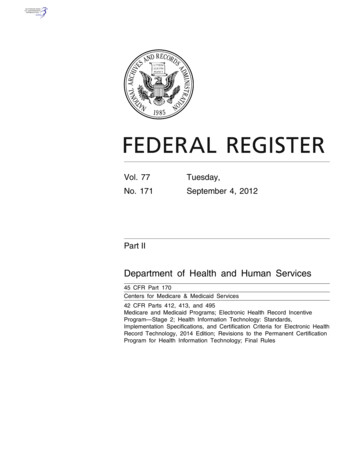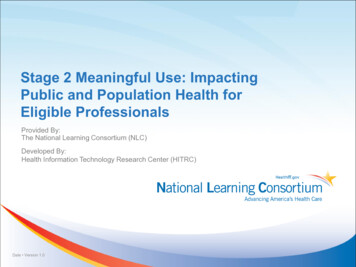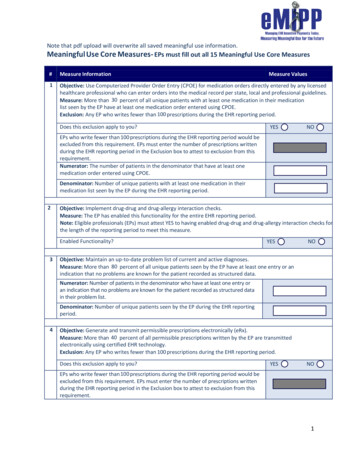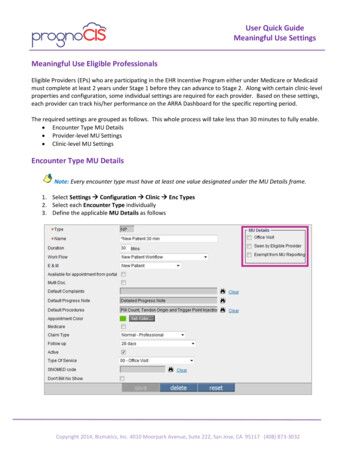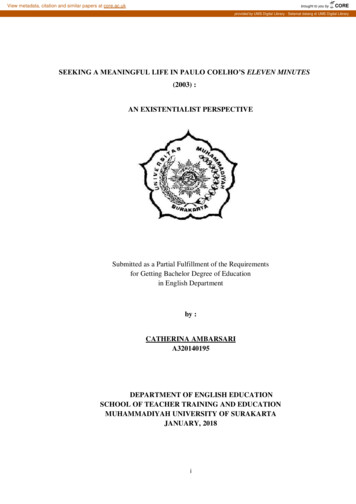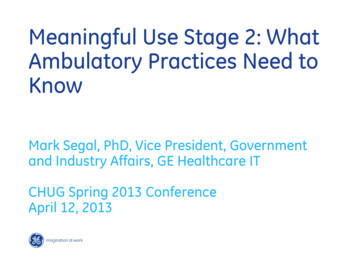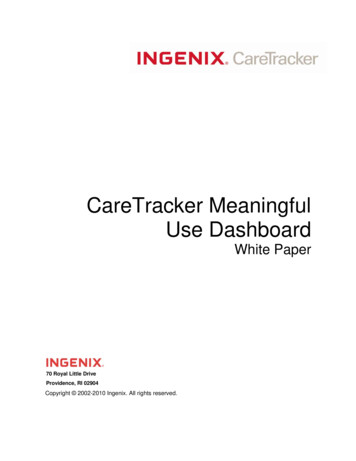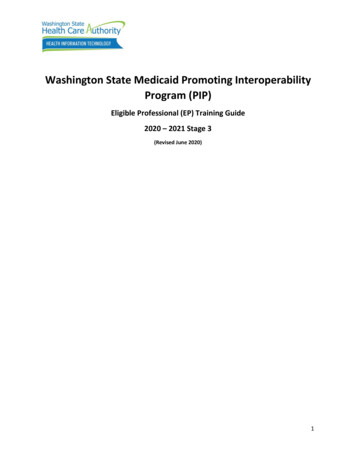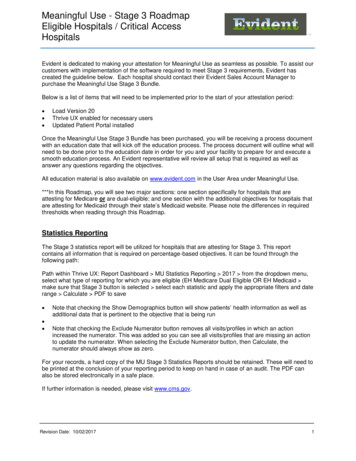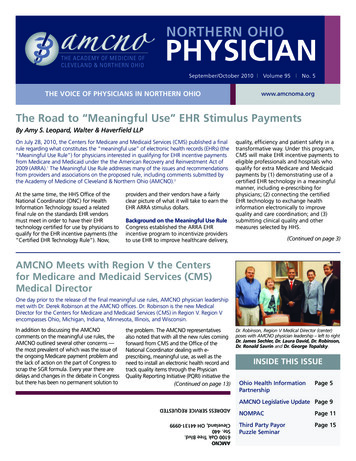
Transcription
NORTHERN OHIOPHYSICIANSeptember/October 2010 Volume 95 No. 5THE VOICE OF PHYSICIANS IN NORTHERN OHIOwww.amcnoma.orgThe Road to “Meaningful Use” EHR Stimulus PaymentsBy Amy S. Leopard, Walter & Haverfield LLPOn July 28, 2010, the Centers for Medicare and Medicaid Services (CMS) published a finalrule regarding what constitutes the “meaningful use” of electronic health records (EHRs) (the“Meaningful Use Rule”) for physicians interested in qualifying for EHR incentive paymentsfrom Medicare and Medicaid under the the American Recovery and Reinvestment Act of2009 (ARRA).1 The Meaningful Use Rule addresses many of the issues and recommendationsfrom providers and associations on the proposed rule, including comments submitted bythe Academy of Medicine of Cleveland & Northern Ohio (AMCNO).2At the same time, the HHS Office of theNational Coordinator (ONC) for HealthInformation Technology issued a relatedfinal rule on the standards EHR vendorsmust meet in order to have their EHRtechnology certified for use by physicians toqualify for the EHR incentive payments (the“Certified EHR Technology Rule”). Now,providers and their vendors have a fairlyclear picture of what it will take to earn theEHR ARRA stimulus dollars.Background on the Meaningful Use RuleCongress established the ARRA EHRincentive program to incentivize providersto use EHR to improve healthcare delivery,quality, efficiency and patient safety in atransformative way. Under this program,CMS will make EHR incentive payments toeligible professionals and hospitals whoqualify for extra Medicare and Medicaidpayments by (1) demonstrating use of acertified EHR technology in a meaningfulmanner, including e-prescribing forphysicians; (2) connecting the certifiedEHR technology to exchange healthinformation electronically to improvequality and care coordination; and (3)submitting clinical quality and othermeasures selected by HHS.(Continued on page 3)AMCNO Meets with Region V the Centersfor Medicare and Medicaid Services (CMS)Medical DirectorOne day prior to the release of the final meaningful use rules, AMCNO physician leadershipmet with Dr. Derek Robinson at the AMCNO offices. Dr. Robinson is the new MedicalDirector for the Centers for Medicare and Medicaid Services (CMS) in Region V. Region Vencompasses Ohio, Michigan, Indiana, Minnesota, Illinois, and Wisconsin.the problem. The AMCNO representativesalso noted that with all the new rules comingforward from CMS and the Office of theNational Coordinator dealing with eprescribing, meaningful use, as well as theneed to install an electronic health record andtrack quality items through the PhysicianQuality Reporting Initiative (PQRI) initiative the(Continued on page 13)Dr. Robinson, Region V Medical Director (center)poses with AMCNO physician leadership – left to rightDr. James Sechler, Dr. Laura David, Dr. Robinson,Dr. Ronald Savrin and Dr. George Topalsky.INSIDE THIS ISSUEOhio Health InformationPartnershipPage 5AMCNO Legislative Update Page 9ADDRESS SERVICE REQUESTEDAMCNO6100 Oak Tree Blvd.Ste. 440Cleveland, OH 44131-0999In addition to discussing the AMCNOcomments on the meaningful use rules, theAMCNO outlined several other concerns —the most prevalent of which was the issue ofthe ongoing Medicare payment problem andthe lack of action on the part of Congress toscrap the SGR formula. Every year there aredelays and changes in the debate in Congressbut there has been no permanent solution toNOMPACPage 11Third Party PayorPuzzle SeminarPage 15
2NORTHERN OHIO PHYSICIANnSeptember/October 2010
MEANINGFUL USEThe Road to “Meaningful Use” EHR Stimulus Payments(Continued from page 1)CMS established a three-stage, graduatedapproach to meaningful use. Each biennialstage will include criteria that become morestringent over time. The stages contemplatean evolution from initially just capturing andusing health information in a structuredformat to tracking clinical conditions and usinghealth IT for order entry, result reporting andimproving quality at the point of care, andfinally to interoperability among EHRtechnologies with clinical decision support.The final rule covers the first two (2) years ofthe incentive program, which begins as earlyas 2011 under Medicare. CMS will proposethe next two stages of criteria for meaningfuluse through future rulemaking. For the firstpayment year only, physicians maydemonstrate meaningful use of certified EHRtechnology over any continuous 90-day periodwithin a calendar year - allowing physiciansusing certified EHR technology in a meaningfulmanner as late as October 1, 2011 to qualifyfor incentive payment for 2011. After the firstyear, however, physicians must demonstratemeaningful use for the entire calendar year.Medicare EHR Incentive ProgramAs originally set forth in ARRA and theproposed rule, Medicare EHR incentivepayments for eligible professionals will be75% of Medicare fee-for-service allowablecharges up to an annual cap for up to fiveyears beginning in calendar year 2010. (SeeMedicare Incentives Table pg. 6.) Eligibleprofessionals can receive up to a total of 44,000 over a five-year consecutive period,including 18,000 in the first year for earlyadopters qualifying by calendar year 2012.Eligible professionals must begin by 2014 andthe last payment year is 2016. Eligibleprofessionals furnishing more than 50% oftheir Medicare covered services in a healthprofessional shortage area (HPSA) earn anadditional 10%. Eligible professionals who donot establish meaningful use by 2015 will facereductions in their Medicare fee schedule.Medicare carriers will pay physiciansdemonstrating meaningful use in a singlelump sum payment during each annualreporting period. The payments will be madeto the physician or to a single employer undera valid Medicare reassignment. Physicianscannot allocate payments among multipleentities. Most health systems and grouppractices will want to review their employmentand professional contractor agreements anddetermine who is entitled to receive thepayments. CMS makes clear that the purposeof the Medicare EHR incentive payments is notto be a reimbursement or cost pass through ofsoftware costs to encourage purchasing andadopting EHR technology, but to be anincentive to actually use the EHR technology ina manner that supports the HITECH healthpolicy priorities.Medicaid EHR Incentive ProgramMedicaid payments will be made throughthe states and states must prepare a healthinformation technology plan to receive theCMS match for their EHR incentiveprograms. The Medicaid incentive programwill allow eligible professionals and hospitalsto qualify for initial payments beforeachieving meaningful use. Eligibleprofessionals who adopt, implement, orupgrade their certified EHR technology in thefirst payment year are still eligible forMedicaid payments during the firstparticipation year only and do not have tomeet the meaningful use objectives andassociated measures of the Stage 1 criteriauntil the second participation year.Multiple ProgramsUnlike hospitals that may obtain both Medicareand Medicaid incentives, physicians mustchoose between the Medicare and MedicaidEHR incentive program. However, a one-timeswitch between programs can be made before2015. Choosing between the two programsrequires an analysis of the different paymentamounts, years and whether the physician hasreceived any cash support payments (e.g.,hospital EHR donations).In the final rule, CMS allows eligibleprofessionals to also participate in theMedicare Physician Quality Reporting Initiative(PQRI) and the Medicare EHR Demonstrationwhile participating in the Medicare EHRIncentive Program. However if an eligibleprofessional participates in the Medicare eprescribing incentive program, they cannotparticipate in the Medicare EHR Incentiveprogram in the same year, but could choose toparticipate in the Medicaid EHR IncentiveProgram. HHS is required under the recenthealth reform legislation to develop a plan tointegrate the EHR incentive programs andPQRI by January 1, 2012.CMS defines this as requiring eligibleprofessionals to at least (1) acquire, purchaseor secure access to certified EHR technology,(2) install or begin utilization of certified EHRtechnology capable of meeting meaningfuluse requirements, or (3) upgrade from existingtechnology to certified EHR technology or addnew functionality to meet the definition ofcertified EHR technology at the practice site,including staffing, maintenance, and training.Eligibility and the Hospital-basedExclusionThe strongest recommendation from theAMCNO was that CMS should ensure thebroadest possible physician participationallowed by statute. Medicare and Medicaidare separate and distinct programs withdiffering eligibility requirements, butphysicians could qualify under either EHRincentive program. Under the Medicareprogram, the professionals eligible for theThe Medicaid EHR incentive program paysincentives are doctors of medicine oreligible professionals up to 63,750 over a 6osteopathy, dental surgery and medicine,year period for most physicians. (See Medicaid podiatrists, optometrists, and chiropractorsIncentives Table pg. 6.) The maximumparticipating in Medicare. Physicians, dentists,Medicaid incentive payment is 21,250 in the certified nurse-midwives, nurse practitioners,first payment year and 8,500 annually in five and physician assistants who practicesubsequent years, with pediatricians in thepredominantly in a federally qualified health20-29% Medicaid patient volume corridorcenter (FQHC) or rural health clinic (RHC) if itreceiving one-third less. There is no HPSAis led by PAs are all eligible for the Medicaidbonus. Physicians must enter the MedicaidEHR program by meeting certain patientEHR incentive program by 2016 to receive full volume criteria. The Medicaid EHR programMedicaid incentive payments availablevolume requirements are 30% of Medicaidthrough 2021.patient encounters, with an allowance forpediatricians having at least 20% of MedicaidConsistent with the proposed rule, CMSpatient encounters to qualify at a reducedallows that the Medicaid payment amount for level, and a special formula allowingany particular professional to be reduced forprofessionals who practice predominantly inEHR technology or support service paymentsFQHC and RHCs to meet the 30% thresholdreceived from outside sources other than state by serving needy individuals, such as patientsor local governments. This reduction can be up covered by CHIP, sliding scale, and free care.to 29,000 in the first year or 10,610 insubsequent years. However, technologyHospital-based eligible professionals are notprovided through an employer-employeeeligible for Medicare or Medicaid incentiverelationship, vendor discounts, and in-kind(Continued on page 4)contributions do not need to be backed out.NORTHERN OHIO PHYSICIANnSeptember/October 20103
MEANINGFUL USEThe Road to “Meaningful Use” EHR Stimulus Payments(Continued from page 3)payments. Unfortunately the ARRA definitionwas ambiguous and subject to a broadinterpretation. CMS originally proposed toexclude all professionals furnishing 90% ormore of their professional services in a hospitalinpatient, outpatient or emergency departmentusing place of service codes on the professionalclaim form to calculate eligibility. AMCNO wasvery concerned about the expansive definitionof hospital-based physicians in the proposedrule and argued that CMS should interpret thestatute considering the goals of ARRA topromote EHR adoption. The AMCNO arguedthat CMS should interpret the statuteconsidering the goals of ARRA to promote EHRadoption and provided CMS with severalalternatives consistent with the statute. Inconjunction with area academic medicalcenters and integrated health systems,AMCNO estimated that this proposal wouldhave a devastating effect on the number oflocal physicians eligible to participate.AMCNO recommended that CMS eliminatethe hospital outpatient department place ofservice code 22 from the exclusion criteria. OnApril 15, 2010, President Obama signed theContinuing Extension Act of 2010 to amendthe statutory definition of hospital-based EPs.After reviewing public comments and theamendment, CMS revised the definitionaccordingly. Under the final Meaningful UseRule, if more than 90% of an eligibleprofessional’s services on claim forms areprovided in the Inpatient Hospital place ofservice code 21 or Emergency Departmentplace of service code 23, the professional willnot qualify for incentive payments. CMSestimates that the revised definition wouldexcludes only 14% of Medicare eligibleprofessionals, down from 27% in theproposed rule. This revised definition excludesmany hospitalists and traditional hospitalbased eligible professionals, but allows manyprimary care physicians and others practicingin a hospital outpatient department setting.Realistic Objectives and MeasuresAMCNO expressed concern in its commentsover the breadth and depth of the objectivesand measures required under the proposed ruleand suggested that CMS scale back themeasures to eliminate the “all or nothing”approach to qualification. In particular, theAMCNO expressed concern that requiringphysicians to directly enter 80% of their ordersfor ancillaries, obtaining 50% of all lab resultsin the EHR, and requiring e-prescribing for 75%of permissible prescriptions were too high.4NORTHERN OHIO PHYSICIANnIn a welcome relief, CMS lowered the thresholdsfor most objectives and provided for a core setof objectives and a menu (optional) set ofcriteria from which to choose. Beginning inStage 1, eligible professionals must demonstratethat they meet a core set of 15 objectives, and amenu set allowing the professional to choose 5out of 10 other measures. In Stage 2, allStage 1 objectives will be core. (See page 6for information on these objectives).CMS also lowered the thresholds for many ofthe objectives it retained. For example, usingcomputerized physician order entry (CPOE) forat least 80% of all ambulatory EHR orders waslowered to 30% of patients that havemedication orders, with at least one medicationordered through CPOE. Eligible professionals willneed to transmit more than 40% of allpermissible prescriptions electronically.Professionals must implement at least oneclinical decision support rule relevant to theirspecialty or high clinical priority and be able totrack compliance with that rule, down from the5 decision support rules initially proposed.While lowering thresholds, CMS held the line onrequiring health information to be recorded asstructured data. The requirement to maintain anactive problem list for at least 80% of uniquepatients must be recorded as structured data,and eligible professionals must still maintain atleast 80% of all active medications andmedication allergies as structured data.Quality MeasuresThe AMCNO commented that the initial list ofquality measures should be scaled back to arealistic level with only a few straightforward,achievable measures clearly identified for eachspecialty. Those measures should be evidencebased measures having full endorsement by therespective medical specialty societies and at thelevel of maturity where implementationspecifications have already been developed. Inthe final rule, CMS limited the Stage 1 measuresto those that are already in existence and notunder development, but stated that they willseek to align the quality measures for Stage 2with other quality measures development andreporting related to health care reform andother CMS quality measures programs.Administrative BurdensThe AMCNO commented that CMS shouldstreamline the administrative burden onphysicians for easier creation of the compliancedocumentation, especially considering thetechnical criteria and the potential for manualSeptember/October 2010calculations. In 2011, eligible professionalsmust submit aggregate clinical quality measurenumerator, denominator, and exclusion data toCMS or the States by attestation, and CMSnow estimates about 9 1/2 hours for EligibleProfessionals to attest and report objectivesand quality measures during the first year.Despite commentator concerns that CMScompliance burden estimates were far too low,CMS says it believes that EHR technology willhelp reduce the burden as it evolves tocalculate the clinical quality measures requiredfor meaningful use incentives. State Medicaidprograms will have some flexibility on howthey approach provider compliancedocumentation, although CMS will review thestate attestation and provider reportingmechanisms before they are implemented.The EHR Technology RuleWhat is most important is that the EHRtechnology not only meet the certificationcriteria, but actually be certified. ARRA requiresproviders to use EHR technology certified byONC. The Certified EHR Technology Ruleadopted by ONC provides certificationstandards and a pathway for EHR vendors tohave their technology certified, either as acomplete EHR or as one or more EHR modules.Vendors are now gearing up to ensure thattheir software has the capabilities required orcan work with other certified modules to allowproviders to meet the minimum standards foran EHR, including the standards fordemographics, history and problem list, clinicaldecision support, physician order entry, qualitymeasures, and exchanging information.Eligible professionals should be working withtheir vendors to confirm that the vendor canand will pursue certification of the technologyunder the initial standards and is committed toramping up over the three stages.The AMCNO plans to continue to provide ourmembers with educational materials andupdates on this issue in the coming months.Amy S. Leopard heads the health care practicegroup at the law firm of Walter & Haverfield LLPand may be reached at aleopard@walterhav.com.This article presents general information andeducation on legal developments and doesnot constitute legal advice.1This article updates “The Proposed Pathwayfor Achieving 'Meaningful Use' and EHRStimulus Payments,” Northern Ohio Physician(March/April 2010).2 The AMCNO comments on the January 2010proposed rule are posted on the website. n
ELECTRONIC HEALTH RECORDSThe Ohio Health Information Partnership (OHIP) to AssistPhysicians with Electronic Health Record Selection andMeaningful Use IncentivesDo you have an electronic health record (EHR) system? If you do, will you be able to collect 44,000 or 63,750 from Medicare or Medicaid with your system? If you aren’t sure or needhelp setting up an EHR system, the Ohio Health Information Partnership (OHIP) is here to help.The Ohio Health Information Partnership(OHIP) is a non-profit entity, funded througha combination of state and federal grants, toassist physicians and other providers withimplementation and adoption of healthinformation technology (HIT) throughout Ohio.OHIP’s MissionOHIP was created as a result of two grantawards created from the American Recoveryand Reinvestment Act (ARRA) legislation thatwas enacted in 2009. OHIP’s mission is toimprove the quality and value of health care byallowing authorized providers to have access toa patient’s health information regardless of thecare setting. The overall goal of OHIP is toimprove health care quality, outcomes andexperience for the citizens of Ohio.OHIP is committed to assisting 6,000physicians adopt and “meaningfully use” anEHR by 2012. Nationally, the goal is to have100,000 physicians adopt an EHR within thenext few years. By the end of the decade, theU.S. Department of Health and HumanServices would like to have at least 75% of allphysicians adopt an EHR.Statewide Health Information ExchangeOne of OHIP’s two grant awards was fundingto build a statewide health informationexchange (HIE) for Ohio. The purposes of thegrant and subsequent HIE are to accelerate theelectronic exchange of health informationamong health care providers, hospitals, labs,pharmacies and other groups and to ensurethat the exchange conforms to all establishedprivacy and security requirements.Qualifying for Federal IncentivesOHIP’s other grant award provided funding tocreate a Regional Extension Center (REC) thatwould be responsible for assisting Ohioproviders with the purchase, adoption andimplementation of electronic health records(EHRs). This grant allows OHIP to providesubsidized services that will offer practiceworkflow redesign and implementationassistance to make the selection of an EHRsystem easier for health care providers. OHIPalso plans to promote greater EHR adoption by:1. Providing physicians and other providerswith access to free or low cost experiencedconsultants who will work with individualpractices to provide assistance throughoutthe selection, adoption, implementation,and use of an EHR. OHIP will workthrough seven Regional Partners who havea wide range of EHR expertise to make theEHR adoption process easier and quicker.2. Vetting EHR vendors to identify those thatare best able to meet practice needs andnegotiating discounts with those vendors.3. Helping providers meet “meaningful use”standards. Meeting these standards, whichwere recently defined by the Office of theNational Coordinator, is necessary in orderto qualify for financial incentives throughMedicare and Medicaid.In addition, OHIP will be identifying sources oflow interest loans for providers who wish topurchase an EHR.OHIP: Providing Services through itsSeven Regional PartnersTo assure that health care providers in Ohiohave access to easily reachable, hands-on helpin selecting, implementing, and achieving“meaningful use” OHIP has contracted withseven Regional Partners which act as thetechnical assistance arm for adoption of EHRs.The Regional Partners in conjunction withOHIP will work with health care providers intheir individual regions, offering individualpractices an array of consulting services,including education, outreach, and technicalassistance. Also included will be discountedcertified EHR offerings and a health IT loanprogram. Provide the educational tools thatpractices need to understand themaximum benefits available inimplementing an EHR system. Assist in defining practice-specifictechnical and functional requirements. Assist in the selection and acquisition of acertified EHR system. Provide information regarding thelow-cost loans available through OHIPto enable practices to purchase theequipment they need. Serve as liaison between practices andEHR vendors regarding the technicalassistance they need to “go live.” Help practices meet federally-mandated“meaningful use” requirements. NOTE:If/when it is documented these standardsare met, the practice could then qualifyfor the Medicare/Medicaid financialincentives for adoption of an EHR thatare being made available through theAmerican Recovery and ReinvestmentAct of 2009.Qualification Requirements and Cost forRegional Partner ServicesThe cost of the Regional Partner services issubsidized for primary care providers (PCP):MDs or DOs who are family physicians,general internists, pediatricians or obstetrician/gynecologists (board certification not required)and who practice in individual or groupsettings of fewer than ten physicians.Other qualifying primary care providers arenurse practitioners, nurse midwives, andphysician assistants with prescriptive privileges.Priority is also given to PCPs who provideprimary care services in the following settings:(1) public or critical access hospitals; (2)Federally Qualified Health Centers (FQHCs);(3) rural health clinics; and (4) other settingsfor predominantly uninsured, underinsured,or medically underserved populations. Directtechnical assistance will be capped at theten-provider level for groups with more thanten physicians/providers.Qualifying for Federal Financial IncentivesAs part of the overall effort to increase theadoption rate of EHR, the Centers forMedicare and Medicaid Services is offeringfinancial incentives to Eligible Professionals(EPs) for attaining meaningful use.The term “meaningful use” describes a setof objectives that providers must meet todemonstrate that they are using their certifiedEHR software in a meaningful way. Providersmust be able to demonstrate “meaningful use”in order to qualify for federal financial incentives.The measures that are used to gaugemeaningful use are meant to improve healthcare quality, efficiency, and patient safety.There are five goals of Meaningful Use:1. Improve quality, safety, efficiency, andreduce health disparities.2. Engage patients and families.3. Ensure adequate privacy and securityprotections for personal healthinformation.NORTHERN OHIO PHYSICIAN(Continued on page 6)nSeptember/October 20105
ELECTRONIC HEALTH RECORDSThe Ohio Health Information Partnership (OHIP)(Continued from page 5)4. Improve population and public health.Are you eligible? How do you qualify? Whatare the timelines and deadlines? How do youregister? For answers to these questionsand the specifics about the programgo to www.ohiponline.org or emailinfo@ohiponline.org or contact one of theregional extension centers in the NorthernOhio region listed below:REGIONAL CONTACTS:Case Western Reserve University,Joseph Peter, joseph.peter@case.edu(216) 368-5756 (For counties: Ashtabula,Cuyahoga, Geauga, Lake, and Lorain)Akron Regional Health Foundation,Marianne Lorini, mlorini@arha.org(330) 873-1500 (For counties: Ashland,Carroll, Harrison, Holmes, Medina, Portage,Richland, Stark, Summit, Tuscarawas, andWayne.) nWHAT PHYSICIANS NEED TO DOFor the first round of Medicare andMedicaid EMR bonuses in 2011-12,physicians must meet 15 core objectives andat least five of 10 “menu set” items. Eachobjective has a measure to determine if anEMR was used to perform the function foran appropriate number of opportunities:Core set (must meet all) Record patient demographics Record vital signs/chart changes Maintain current and active diagnoses Maintain active medication list Maintain active allergy list Record adult smoking status Provide patient clinical summaries Provide electronic health informationcopy on demand Generate and transmit prescriptionselectronically Use computerized physician order entryfor drug orders Implement drug-drug/drug-allergyinteraction checks Be capable of electronic clinicalinformation exchange Implement one clinical decision support rule Protect patient data privacy and security Report clinical quality measures to CMSor statesMenu set (can defer up to five for2011-12) Implement drug formulary checks Incorporate clinical lab test results Generate patient lists by condition Identify patient-specific education resources Perform medication reconciliationbetween care settings Provide summary of care for transferredpatients Submit electronic immunization data toregistries Submit electronic epidemiology data topublic health agencies Send care reminders to patients Provide timely patient electronic accessto health informationSource: Centers for Medicare &Medicaid wnloads/NPRM vs FR Table Programs/Downloads/EHR Incentive Program AgencyTraining v8-20.pdfThis article in the New England Journalof Medicine provides another tableoutlining the menu sets.“The ‘Meaningful Use’ Regulation forElectronic Health Records,” New EnglandJournal of Medicine, July 13(healthcarereform.nejm.org/?p 3732)6NORTHERN OHIO PHYSICIANnSeptember/October 2010
COMMUNITY ACTIVITIESMedicaid Conducts a Learning Session on the MedicaidProvider Incentive Payment Program (MPIP)In August, the AMCNO staff was pleased to participate in a strategic learning sessionconducted by the Ohio Department of Job and Family Services (ODJFS), Office of OhioHealth Plans concerning the State Medicaid Health Information Technology Plan, and theMedicaid Provider Incentive Payment Program (MPIP) at Case Western Reserve School ofMedicine (CWRU). The MPIP program offers 63,750 over six years to eligible professionalswho adopt and meaningfully use certified electronic health records (EHRs). It can also applyto professionals who upgrade their existing EHR capabilities. Hospitals are also eligible toparticipate in the MPIP program.State Medicaid executive leadershipprovided an overview of Ohio Medicaid’sgoals regarding health informationtechnology and participants provided theirinput on the incentive program.Participants discussed the adoption ofEHRs, the history of meaningful use, andthe hurdles providers will face to meetStage 1 meaningful use criteria.As noted in the meaningful use article onpage one in this issue, eligibleprofessionals (EPs) for Medicaid includephysicians (pediatricians have specialeligibility and payment rules), nursepractitioners, certified nurse midwives,dentists and physician assistants (PA) whoODJFS representatives have been travelingaround the state of Ohio trying to gatherinformation from providers, consumersand others regarding the roll out of thisplan. In order for Ohio Medicaid toreceive the federal money for thisprogram CMS had to approve their planto work with stakeholders to defineOhio’s current state of HIT and EHR,where Ohio plans to be in five years withlead a federally qualified health center orregard to HIT and EHR, and a road maprural health clinic that is directed by a PA.for getting to the vision and the basis ofPatient volume must be at 30% with theexception of pediatricians (20%). Medicaid the MPIP program — i.e., their StateMedicaid Health Information Plan (SMHP)is different than Medicare in that — EPsmay adopt and implement in 2011 and be and Ohio’s I-APD (implementation of theup and running by 2012 in order to qualify. plan). Ohio Medicaid representatives areworking to define these parameters withThe meaningful use definition will bethe intent to develop and submit thecommon with Medicare, however, underMedicaid states can choose to adopt more SMHP to CMS by November and thendevelop and submit the I-APD to CMSrigorous definitions. An example of thisupon approval of the SMHP. The plannedmight be reporting of public healthimplementation of MPIP
final rule on the standards EHR vendors must meet in order to have their EHR technology certified for use by physicians to qualify for the EHR incentive payments (the "Certified EHR Technology Rule"). Now, . 2015. Choosing between the two programs requires an analysis of the different payment amounts, years and whether the physician has


